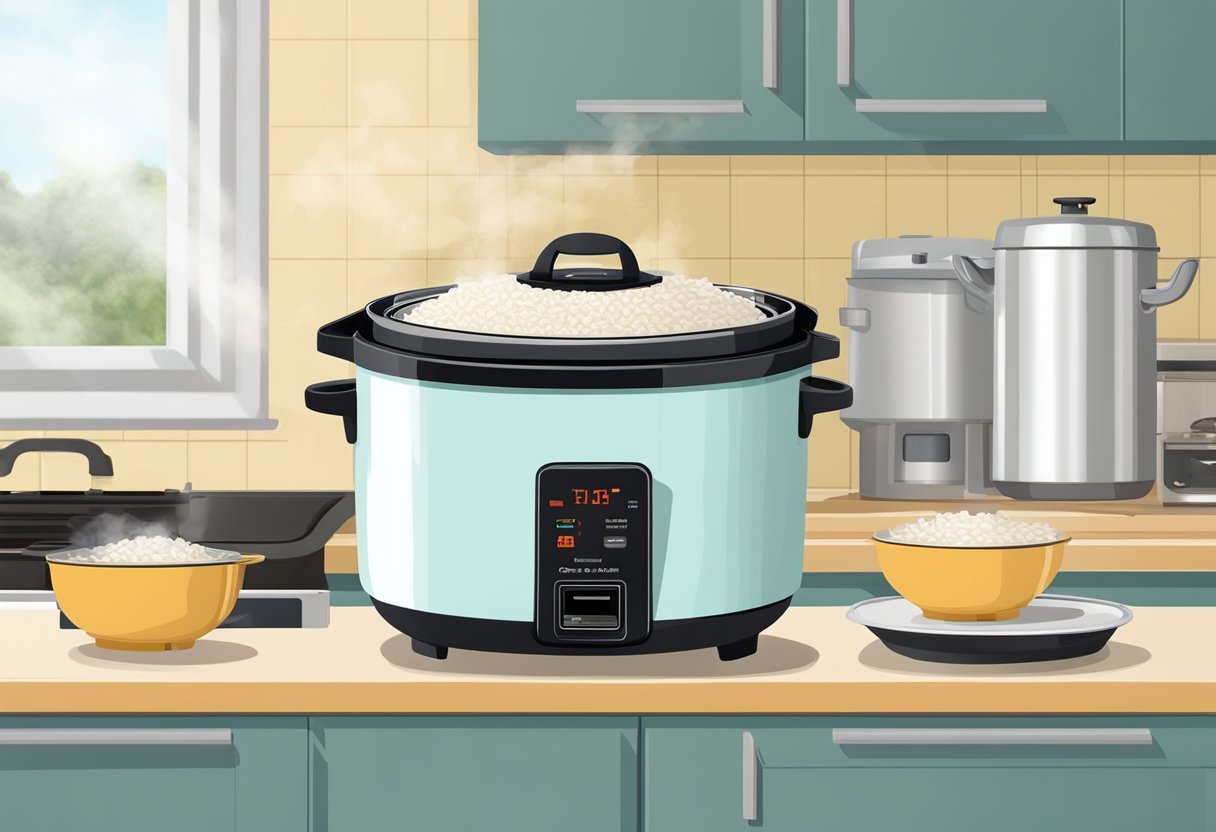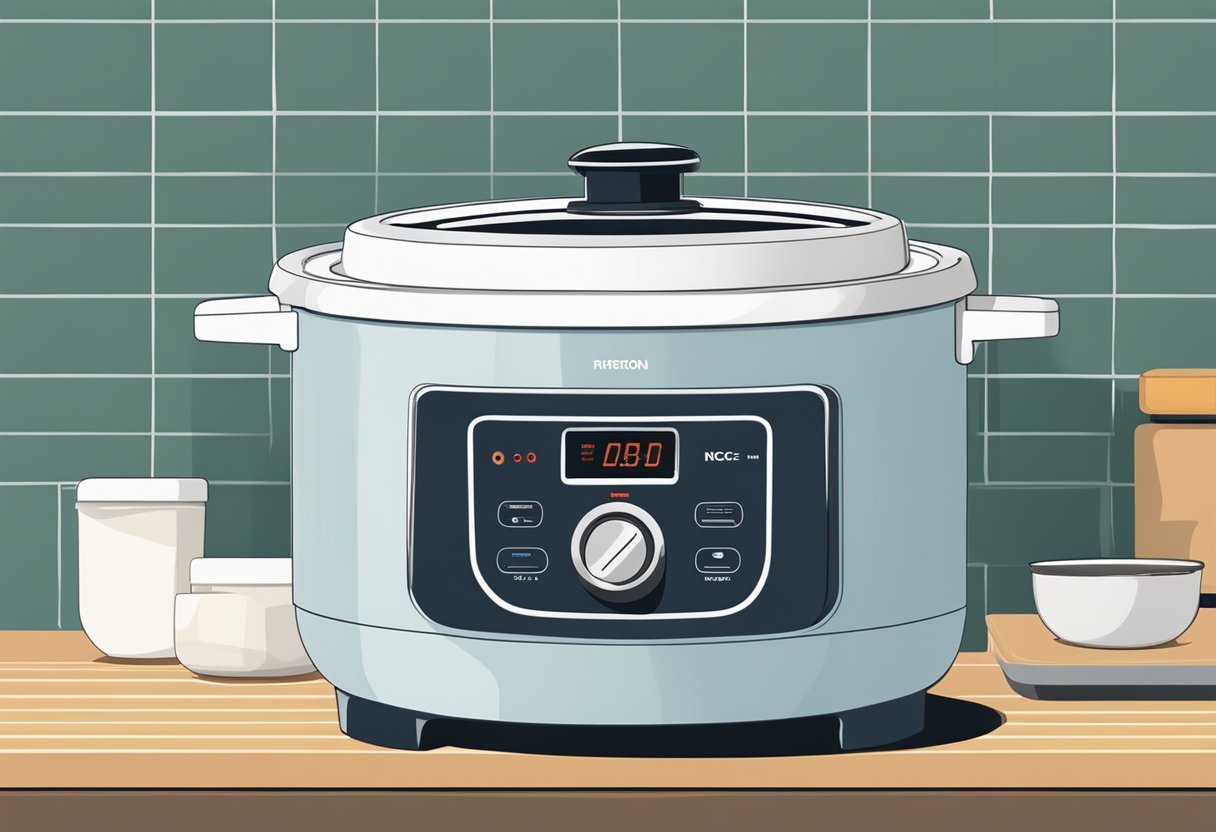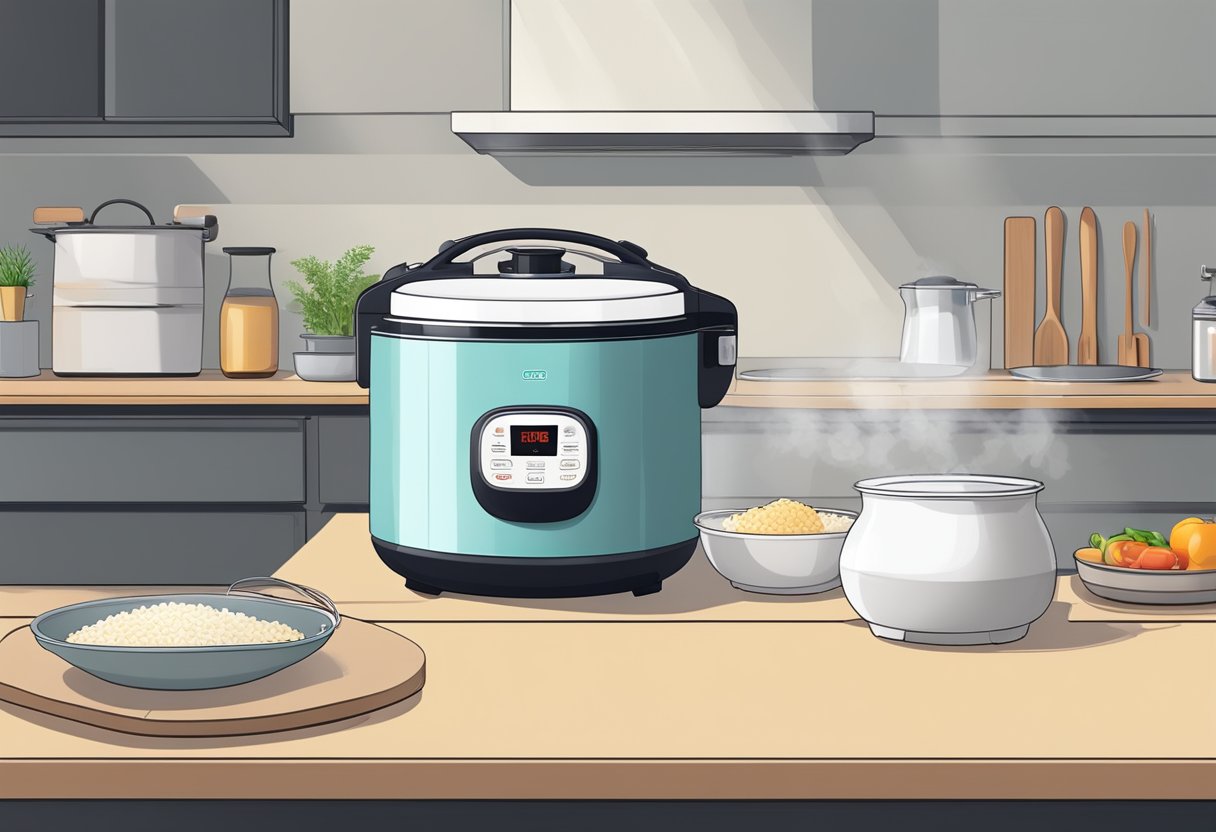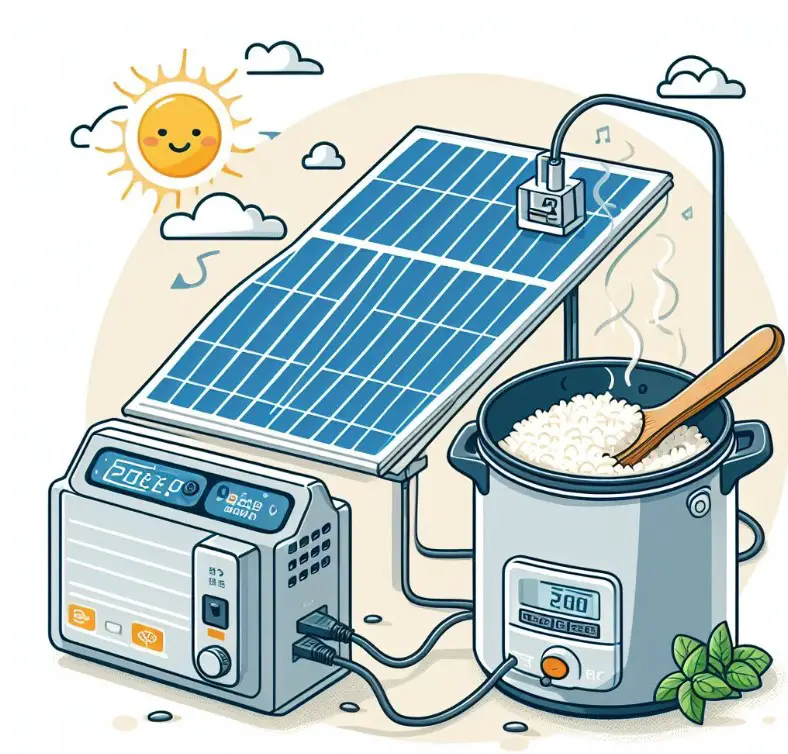I have always been fascinated by the versatility and convenience of rice cookers. These kitchen appliances have been around for decades and have become an essential tool in many households worldwide.
However, one question that often comes up is whether rice cookers work on inverters. In this article, I will explore this topic and provide you with all the information you need to know.

Understanding rice cookers is essential before we delve into whether they work on inverters. Rice cookers are kitchen appliances designed to cook rice automatically. They consist of a heat source, a cooking pot, and a thermostat that measures the temperature of the cooking pot and controls the heat.
When you plug in the rice cooker, the heating element turns on and heats up the water in the pot. Once the water reaches boiling point, the rice cooker switches to a simmer mode, where it maintains a constant temperature to cook the rice.
Types of rice cookers vary from basic models with only an on/off switch to more advanced ones with multiple settings and features.
The type of rice cooker you have will determine whether it can work on an inverter or not. In the next section, we will explore the role of inverters in rice cookers and whether you can cook rice with a rice cooker on an inverter.
Key Takeaways
- Rice cookers are automated kitchen appliances designed to cook rice automatically.
- The type of rice cooker you have will determine whether it can work on an inverter or not.
- Inverters can be used to power some rice cookers, but it’s important to select the right one and follow proper safety guidelines.
Understanding Rice Cookers
Rice cookers are an essential kitchen appliance for many households, especially for those who consume rice regularly. They are designed to cook rice automatically, saving time and effort. In this section, I will explain the components of a rice cooker and how it works.
Components of a Rice Cooker
A rice cooker consists of several components that work together to cook rice. The main components are:
- Heating element: This is the part that generates heat to cook the rice. It is usually located at the bottom of the rice cooker.
- Thermostat: This component controls the temperature inside the rice cooker. It turns off the heating element when the rice is fully cooked.
- Sensor: The sensor detects the temperature and moisture level inside the rice cooker. It sends a signal to the thermostat to turn off the heating element when the rice is cooked.
- Inner pot: This is the pot where the rice is cooked. It is usually made of non-stick material to prevent the rice from sticking to the pot.
- Lid: The lid covers the inner pot and prevents steam from escaping.
How Does a Rice Cooker Work
A rice cooker works by using steam and heat to cook rice. The process is simple and straightforward:
- Add the desired amount of rice and water to the inner pot.
- Close the lid and turn on the rice cooker.
- The heating element heats up the water, which creates steam.
- The steam rises and cooks the rice.
- The sensor detects the temperature and moisture level inside the rice cooker and sends a signal to the thermostat to turn off the heating element.
- The rice cooker switches to the “keep warm” mode, which keeps the rice warm until it is ready to be served.
In summary, a rice cooker is a simple and efficient appliance that makes cooking rice easy and convenient. It uses steam and heat to cook rice automatically, and it has several components that work together to achieve this.
Types of Rice Cookers

When it comes to rice cookers, there are several types available in the market. Each type has its own unique features and functionalities. In this section, I will discuss the three most common types of rice cookers: Simple Rice Cookers, Fuzzy Logic Rice Cookers, and Induction Heating Rice Cookers.
Simple Rice Cookers
Simple rice cookers are the most basic type of rice cookers. They work by heating the rice and water to boiling point, and then automatically switching off when the rice is cooked. These cookers are easy to use and affordable, making them a popular choice for many households.
Simple rice cookers are ideal for cooking white rice, but they may not be suitable for cooking other types of rice, such as brown or wild rice.
Fuzzy Logic Rice Cookers
Fuzzy Logic Rice Cookers are the next step up from simple rice cookers. They are equipped with sensors that can detect the temperature and humidity inside the cooker. This allows the cooker to adjust the cooking time and temperature according to the type of rice being cooked.
Fuzzy Logic Rice Cookers are more versatile than simple rice cookers, as they can cook a variety of rice types, including brown rice, sushi rice, and porridge.
Induction Heating Rice Cookers
Induction Heating Rice Cookers are the most advanced type of rice cookers. They use electromagnetic induction to heat the cooking pot, which results in a more even distribution of heat.
This type of rice cooker is ideal for cooking all types of rice, including brown rice and sushi rice. Induction Heating Rice Cookers are also equipped with fuzzy logic technology, which allows them to adjust the cooking time and temperature according to the type of rice being cooked. However, they are also the most expensive type of rice cooker.
In conclusion, the type of rice cooker you choose will depend on your personal preferences and needs. Simple Rice Cookers are affordable and easy to use, but they may not be suitable for cooking all types of rice.
Fuzzy Logic Rice Cookers are more versatile and can cook a variety of rice types. Induction Heating Rice Cookers are the most advanced type of rice cookers, but they are also the most expensive.
The Role of Inverters
What is an Inverter?
An inverter is an electronic device that converts direct current (DC) to alternating current (AC). It is commonly used in solar power systems, uninterruptible power supplies (UPS), and electric vehicles. Inverters are also used in household appliances such as refrigerators, air conditioners, and rice cookers.
Inverters are essential for rice cookers that use fuzzy logic technology. Fuzzy logic rice cookers use sensors to detect the temperature and moisture level inside the cooker. The inverter then adjusts the power output to maintain a consistent temperature and cook the rice evenly.
Compatibility with Rice Cookers
Not all rice cookers are compatible with inverters. Some rice cookers have a heating element that is not designed to work with the variable output of an inverter. It is important to check the specifications of the rice cooker before using it with an inverter.
In general, rice cookers that have an inverter built-in are more efficient and have better heat distribution than rice cookers without inverters.
Inverters can help reduce power consumption by up to 50% compared to conventional rice cookers that do not use an inverter. Additionally, rice cookers with inverters tend to have longer lifespans and are more durable.
In conclusion, inverters play a crucial role in the operation of modern rice cookers. They help maintain consistent heat distribution and reduce power consumption. When choosing a rice cooker, it is important to check if it is compatible with an inverter and to consider the benefits of using an inverter for better efficiency and durability.
Cooking with a Rice Cooker on an Inverter

As an avid camper and lover of rice dishes, I often find myself wondering whether I can use my rice cooker on an inverter. After conducting some research and experimenting, I have found that it is indeed possible to cook rice using a rice cooker on an inverter.
Energy Requirements
One of the most important considerations when using a rice cooker on an inverter is the energy requirements. Rice cookers typically require a significant amount of energy to operate, which means that you need to ensure that your inverter can supply the necessary power.
To determine the energy requirements of your rice cooker, check the wattage rating on the appliance. Most rice cookers require between 300 and 800 watts of power to operate, depending on the size and model. Once you know the wattage rating, you can choose an inverter that can supply the necessary power.
Adjusting Cooking Methods
When cooking with a rice cooker on an inverter, it is important to adjust your cooking methods to ensure that the rice is cooked properly. One of the most important adjustments is the rice-to-water ratio.
Most rice cookers use a 1:1.5 or 1:2 ratio of rice to water, depending on the type of rice being cooked. However, when using a rice cooker on an inverter, you may need to adjust the ratio slightly to ensure that the rice is cooked properly.
Another important consideration is the cooking temperature. Rice cookers typically cook rice at a consistent temperature, but when using an inverter, the temperature may fluctuate slightly. To ensure that the rice is cooked properly, you may need to adjust the cooking time or temperature slightly.
In conclusion, using a rice cooker on an inverter is possible with the right equipment and adjustments to your cooking methods.
By ensuring that your inverter can supply the necessary power and adjusting your rice-to-water ratio and cooking temperature, you can enjoy perfectly cooked rice on your next camping trip or outdoor adventure.
Benefits of Using Rice Cookers
As someone who has been using rice cookers for years, I can confidently say that they are a game-changer in the kitchen. Here are a few reasons why:
Convenience and Efficiency
Cooking rice on the stove can be a tedious and time-consuming process. With a rice cooker, all you need to do is add rice and water, and the machine takes care of the rest. Most rice cookers also come with a timer and a “keep warm” function, so you can set it and forget it until you’re ready to eat.
Not only does a rice cooker save you time and effort, but it also saves energy. According to Three Two Home, “rice cookers use less energy than a stove, and they cook rice faster, too.”
Consistent Cooking Results
One of the biggest advantages of using a rice cooker is that it produces perfect rice every time. The machine is designed to measure the rice and water precisely, so you don’t have to worry about overcooking or undercooking the rice.
In addition, the “keep warm” function ensures that the rice stays at the perfect temperature until you’re ready to eat. This means you don’t have to rush to serve the rice as soon as it’s done cooking, and you can enjoy your meal at your own pace.
Easy to Clean
Another benefit of using a rice cooker is that it’s easy to clean. Most rice cookers come with a non-stick inner pot, which means you don’t have to worry about the rice sticking to the bottom of the pot. Simply rinse the pot with water and wipe it down with a soft cloth.
In conclusion, using a rice cooker is a convenient, efficient, and reliable way to cook perfect rice every time. It saves time and energy, produces consistent results, and is easy to clean. If you’re someone who loves rice and wants to make cooking it a hassle-free experience, a rice cooker is definitely worth considering.
Selecting the Right Rice Cooker
When it comes to choosing a rice cooker that works on an inverter, there are several factors to consider. Here are some of the most important things to keep in mind:
Capacity and Size
Rice cookers come in various sizes, ranging from small to large. The size you choose will depend on your needs and the number of people you plan to cook for. If you have a large family or frequently entertain guests, a larger rice cooker may be the best option. However, if you only cook for one or two people, a smaller rice cooker may be more appropriate.
Material and Durability
The material of the rice cooker is also an important factor to consider. There are three main types of materials used in rice cookers: non-stick coating, stainless steel, and aluminum. Non-stick coating is easy to clean and prevents rice from sticking to the pot, but it may not be as durable as stainless steel or aluminum.
Stainless steel and aluminum are both durable, but stainless steel is more expensive than aluminum.
Additional Features
In addition to the capacity and material of the rice cooker, there are also several additional features to consider. Some rice cookers come with a measuring cup and rice paddle, which can be helpful when measuring the amount of rice and stirring it during cooking. Other rice cookers may have additional features such as a timer, a keep-warm function, or a steaming basket for cooking vegetables.
Overall, when selecting a rice cooker that works on an inverter, it is important to consider your specific needs and preferences. By taking into account factors such as capacity, material, and additional features, you can choose a rice cooker that will meet your needs and provide delicious, perfectly cooked rice every time.
Rice Cooker Maintenance and Troubleshooting
As an avid user of rice cookers, I have found that proper maintenance and troubleshooting can extend the life of your rice cooker and ensure that it functions properly. In this section, I will discuss some tips and tricks for maintaining and troubleshooting your rice cooker.
Cleaning Your Rice Cooker
Cleaning your rice cooker is an essential part of its maintenance. Dirt and grime can accumulate on the rice cooker lid, main body, and other parts, which can affect its performance. To clean your rice cooker, follow these simple steps:
- Unplug your rice cooker and allow it to cool down.
- Remove the inner pot and wash it with soap and water. Rinse it thoroughly and dry it.
- Wipe the main body of the rice cooker with a damp cloth. Do not use abrasive cleaners or scrubbers.
- Clean the rice cooker lid with a soft sponge or cloth. Make sure to remove any food particles or dirt.
- Reassemble the rice cooker and store it in a dry place.
Regular cleaning of your rice cooker will ensure that it functions properly and lasts longer.
Common Issues and Solutions
Even with proper maintenance, rice cookers can still experience issues. Here are some common issues and their solutions:
- Overcooked or Undercooked Rice: The wrong rice-to-water ratio can cause your rice to be overcooked or undercooked. Follow the instructions in your rice cooker manual for the correct ratio.
- Rice Sticking to the Bottom: This can be caused by a dirty inner pot or the wrong rice-to-water ratio. Clean the inner pot and adjust the ratio if necessary.
- Rice Cooker Not Turning On: Check to make sure that the rice cooker is plugged in and that the outlet is working. If it still does not turn on, there may be an issue with the power cord or other internal components.
- Rice Cooker Lid Not Closing Properly: This can be caused by a dirty or misaligned lid. Clean the lid and make sure it is properly aligned.
By following these tips and tricks, you can ensure that your rice cooker functions properly and lasts longer.




















